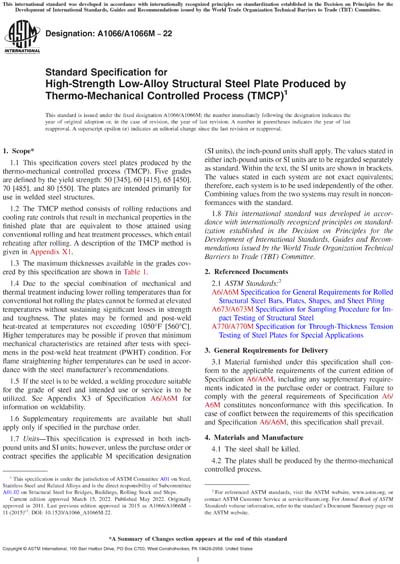Most recent
ASTM A1066/A1066M-22
Standard Specification for High-Strength Low-Alloy Structural Steel Plate Produced by Thermo-Mechanical Controlled Process (TMCP)
1.1This specification covers steel plates produced by the thermo-mechanical controlled process (TMCP). Five grades are defined by the yield strength: 50 [345], 60 [415], 65 [450], 70 [485], and 80 [550]. The plates are intended primarily for use in welded steel structures.
1.2The TMCP method consists of rolling reductions and cooling rate controls that result in mechanical properties in the finished plate that are equivalent to those attained using conventional rolling and heat treatment processes, which entail reheating after rolling. A description of the TMCP method is given in Appendix X1.
1.3The maximum thicknesses available in the grades covered by this specification are shown in Table 1.
1.4Due to the special combination of mechanical and thermal treatment inducing lower rolling temperatures than for conventional hot rolling the plates cannot be formed at elevated temperatures without sustaining significant losses in strength and toughness. The plates may be formed and post-weld heat-treated at temperatures not exceeding 1050°F [560°C]. Higher temperatures may be possible if proven that minimum mechanical characteristics are retained after tests with specimens in the post-weld heat treatment (PWHT) condition. For flame straightening higher temperatures can be used in accordance with the steel manufacturer's recommendations.
1.5If the steel is to be welded, a welding procedure suitable for the grade of steel and intended use or service is to be utilized. See Appendix X3 of Specification A6/A6M for information on weldability.
1.6Supplementary requirements are available but shall apply only if specified in the purchase order.
1.7Units - This specification is expressed in both inch-pound units and SI units; however, unless the purchase order or contract specifies the applicable M specification designation (SI units), the inch-pound units shall apply. The values stated in either inch-pound units or SI units are to be regarded separately as standard. Within the text, the SI units are shown in brackets. The values stated in each system are not exact equivalents; therefore, each system is to be used independently of the other. Combining values from the two systems may result in nonconformances with the standard.
1.8This international standard was developed in accordance with internationally recognized principles on standardization established in the Decision on Principles for the Development of International Standards, Guides and Recommendations issued by the World Trade Organization Technical Barriers to Trade (TBT) Committee.
Content Provider
ASTM International [astm]






